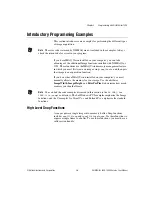
Chapter 3
Programming with NI-IMAQ for 1394
NI-IMAQ for IEEE-1394 Cameras User Manual
3-8
ni.com
High-Level Sequence Functions
Sequence functions include
imaq1394SetupSequence
. A
sequence
initiates a variable-length and variable-delay transfer to multiple buffers.
You can configure the delay between acquisitions with
imaq1394SetupSequence
and specify both the buffer list used for
transfers and the number of buffers.
imaq1394SetupSequence
is
synchronous and returns when all images have been acquired.
Use a sequence in applications where you need to perform processing on
multiple images. Figure 3-4 illustrates a typical sequence programming
order.
Figure 3-4.
Sequence Programming Flowchart
The
Sequence1394.c
example demonstrates how to perform a sequence
acquisition using
imaq1394SetupSequence
. The example sets up a
sequence that uses 10 user-allocated buffers. Each buffer in the sequence
has its own skip count associated with it. The skip count is the number of
frames to skip prior to acquiring the next image. The acquisition is started
at setup time and the setup call is synchronous.
imaq1394CameraOpen
imaq1394CameraOpen
opens
and configures the camera
according to the file set up by
Measurement & Automation Explorer.
User-specific image processing.
imaq1394Close
closes the camera and session.
Set up your buffer list and the
number of the frames that need to
be skipped between each acquisition.
Buffer list setup
User-Specific Functions
imaq1394SetupSequence
initiates a
sequence to a programmable number of buffers.
imaq1394SetupSequence
imaq1394Close
(Loop)
















































